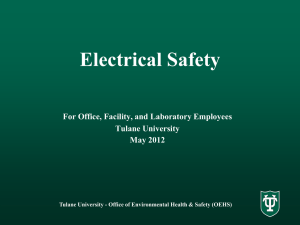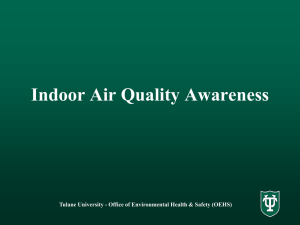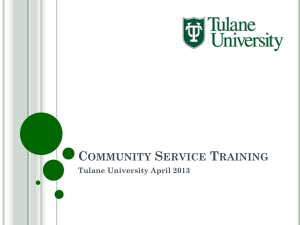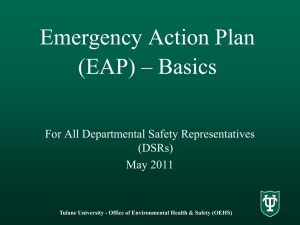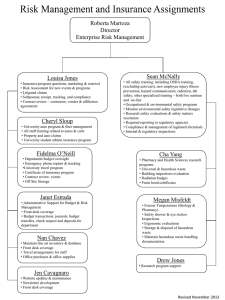Training - Tulane University
advertisement
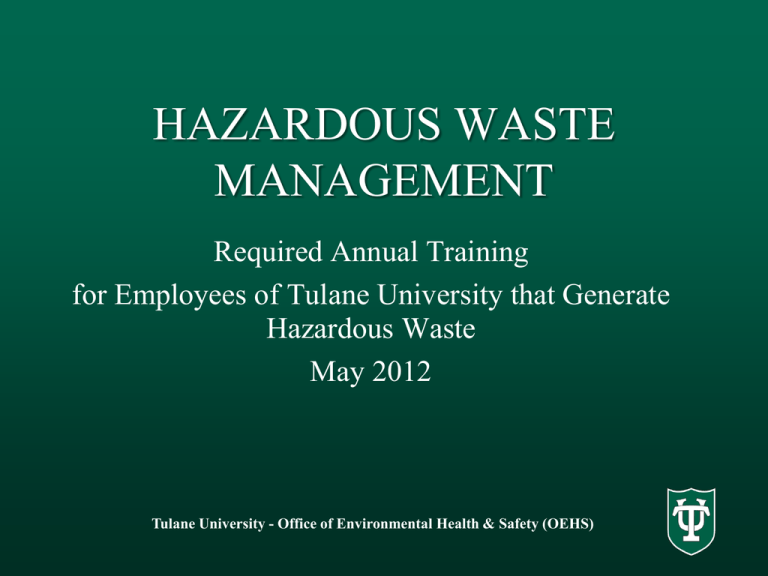
HAZARDOUS WASTE MANAGEMENT Required Annual Training for Employees of Tulane University that Generate Hazardous Waste May 2012 Tulane University - Office of Environmental Health & Safety (OEHS) Objectives • To become familiar with Tulane University’s Policies & Procedures concerning “Hazardous Waste” • To define “Hazardous Waste” (characteristic vs. listed wastes) • To learn how to properly accumulate, store, label, and dispose of “Hazardous Waste” • To learn methods for minimizing the amount of “Hazardous Waste” generated. Tulane University - Office of Environmental Health & Safety (OEHS) Tulane University Policies and Procedures • Tulane’s Policies and Procedures for hazardous materials/waste are located in Section 29 of the Tulane University Environmental Health & Safety Policies and Procedures Manual (http://tulane.edu/oehs/upload/PPMFullWebA.pdf ) • The policies are designed to meet all current federal, state and local regulations concerning the management of hazardous materials and waste. • These procedures are designed to assist people who generate “Hazardous Waste” at the university to safely and appropriately manage their waste. Tulane University - Office of Environmental Health & Safety (OEHS) What is a Hazardous Waste? Characteristic Waste: A substance that meets the EPA classification(s) for any or all of the following characteristics (40 CFR §261 Subpart C); • Ignitability • Corrosivity • Reactivity • Toxicity Tulane University - Office of Environmental Health & Safety (OEHS) Ignitability Characteristic • A liquid with a flash point < 140º F • A non-liquid that “causes fire through friction, absorption of moisture, or spontaneous chemical changes and burns vigorously and persistently” • An ignitable compressed gas • An oxidizer Tulane University - Office of Environmental Health & Safety (OEHS) Corrosivity Characteristic • An aqueous solution with a pH of ≤ 2 or ≥ 12.5 • A liquid that corrodes steel > 0.25 inches (6.35mm) per year Tulane University - Office of Environmental Health & Safety (OEHS) Reactivity Characteristic A material is considered reactive if it; • Is normally unstable and undergoes violent change without detonating • Reacts violently with water • Forms potentially explosive mixtures with water • Produces toxic gases or fumes when mixed with water Tulane University - Office of Environmental Health & Safety (OEHS) Reactivity Characteristic (cont’d) • Is a cyanide or sulfide-containing material that releases toxic gases when exposed to a pH between 2 and 12.5 • It is capable of detonation if struck or heated • Is readily capable of detonation at standard temperature and pressure • Is an explosive Tulane University - Office of Environmental Health & Safety (OEHS) Toxicity Characteristic • The toxicity characteristic is applied to 39 different chemicals (40 CFR §261.24) • The Toxicity Characteristic Leaching Procedure (TCLP) is performed on waste that contains one or more these chemicals • The TCLP simulates landfill conditions to determine how much of the chemical(s) will leach out into environment if disposed in a landfill Tulane University - Office of Environmental Health & Safety (OEHS) Toxicity Characteristic (cont’d) • If the concentration of chemical(s) that leached out (during testing) are equal to or greater than the regulatory level for that particular chemical, then the waste is consider “hazardous” by the toxicity characteristic • If the concentration of chemical(s) that leached out are less than the regulatory level for that particular chemical, then the waste can be disposed of as regular solid waste Tulane University - Office of Environmental Health & Safety (OEHS) What Is A Hazardous Waste? Listed Waste: Waste that the EPA has listed as “hazardous” regardless of its physical characteristics. • Commercial Chemical Products ( P and U Lists) – P- List (40 CFR §261.33(e)): “acutely hazardous” wastes (e.g. physostigmine, sodium azide, strychnine) – U-List (40 CFR §261.33(f)): “non-acutely hazardous” wastes (e.g. formaldehyde, xylene, toluene) Tulane University - Office of Environmental Health & Safety (OEHS) P and U Lists • P-Listed wastes are highly toxic; could be or are fatal to humans and animals in low doses • U-Listed wastes are toxic, but not considered acutely toxic; carcinogens, mutagens, materials that bioaccumulate – Chemicals on the P and U lists are generally “toxic” but can also be ignitable, corrosive, and reactive Tulane University - Office of Environmental Health & Safety (OEHS) What is a Hazardous Waste? Listed Waste Cont’d: • Process Wastes: Wastes from various sources that EPA has determined should be regulated as “hazardous.” ( F and K lists) – F- List (40 CFR §261.31) : wastes from non-specific sources (e.g. spent solvents) – K-List (40 CFR §261.32) : industry specific wastes Tulane University - Office of Environmental Health & Safety (OEHS) How Do I Know if my Waste is “Hazardous?” • Properly characterizing waste streams can be a complicated process, and must be done accurately to ensure that waste is properly treated and disposed. • Please contact Hazardous Waste Specialist, Michael Kopaigorodsky (504) 988-2865, for questions regarding whether or not your waste is “hazardous.” Tulane University - Office of Environmental Health & Safety (OEHS) Empty Container Disposal Generally speaking, empty containers are not considered “Hazardous Waste” and may thrown away with regular solid waste, or in a glass disposal box after the label has been removed or defaced. Tulane University - Office of Environmental Health & Safety (OEHS) Rinsing Empty Containers However, empty containers that previously held “acutely hazardous waste” (P-listed waste) must be triple-rinsed with an appropriate solvent before disposal. The solvent must then be disposed of as a “Hazardous Waste.” Contact the OEHS (504) 988-2865, to determine if you are working with any “acutely hazardous” materials. Tulane University - Office of Environmental Health & Safety (OEHS) Disposing of Empty Containers at the TNPRC • At the Primate Research Center, ALL containers that previously contained hazardous materials must be rinsed, and the first rinse must be collected and then disposed of as “Hazardous Waste”. The container’s label must then be removed or defaced before disposal. • As with all campuses, empty containers that previously held “acutely hazardous waste” (P-listed waste) must be triplerinsed with an appropriate solvent before disposal and the solvent must be disposed of as a hazardous waste. Tulane University - Office of Environmental Health & Safety (OEHS) Accumulating “Hazardous Waste” • Capture waste in rigid containers that are compatible with the waste. • Keep all containers closed (capped) except when hazardous waste is being added to them. • Do not store incompatible wastes together. • Properly label containers once waste has been added. Tulane University - Office of Environmental Health & Safety (OEHS) Accumulating “Hazardous Waste” Use secondary containment such as a tray or a tub to contain hazardous waste in the event that the primary container should leak. Tulane University - Office of Environmental Health & Safety (OEHS) Containerize “Hazardous Waste” • Cans of paint without lids, broken thermometers, and chemically contaminated items must be overpacked into another container which is free of leaks so they can be disposed of safely. • The OEHS will not accept waste that is not properly containerized Tulane University - Office of Environmental Health & Safety (OEHS) To Help Minimize Costs DO NOT MIX WASTES • Only compatible waste solvents should be mixed together in appropriate waste containers • Do not mix acids and flammable materials together • Do not mix biological and chemical waste • Do not mix radiological and chemical waste These practices can greatly reduce the cost of hazardous waste disposal. Tulane University - Office of Environmental Health & Safety (OEHS) Labeling Waste Containers The following information must be on the label: • The words “Hazardous Waste” • The full name of the chemical(s) being placed in the container (no abbreviations or symbols) • Associated hazards (such as flammable, corrosive, reactive, toxic) Tulane University - Office of Environmental Health & Safety (OEHS) Labeling Waste Containers (cont’d) Do not rely on the Hazardous Waste Specialist picking up your waste to label your containers for you. It is the waste generator’s responsibility to properly identify and label waste and waste containers. The OEHS provides “Hazardous Waste” labels upon request. The OEHS does not accept unlabeled waste for disposal Tulane University - Office of Environmental Health & Safety (OEHS) “Hazardous Waste” Disposal Procedures • Maintain waste in your area until collected by the OEHS or brought to the OEHS storage facility. • To schedule a waste pickup, submit an online “Hazardous Waste Pickup Request Form;” http://tulane.edu/oehs/hazard/hazwastepickuprequest.cfm. •Please allow ~ 1 week from the time of form submission to have your waste picked up. Tulane University - Office of Environmental Health & Safety (OEHS) “Hazardous Waste” Disposal Procedures • Tulane is not a licensed disposal facility, NEVER dispose of “Hazardous Waste” by pouring it down the drain or placing it in the trash. • Do not use evaporation as a disposal method. • Under no circumstances may anyone place chemicals in the OEHS waste storage areas unless directed by the Hazardous Waste Specialist or other OEHS personnel. Tulane University - Office of Environmental Health & Safety (OEHS) Disposal Costs • The OEHS is responsible for the cost of disposal associated with chemical waste from laboratories and other areas that is generated through normal research and work activities. • The OEHS is not responsible for the cost for disposing of unwanted/old chemicals from principle investigators/researchers/others separating from the University. Tulane University - Office of Environmental Health & Safety (OEHS) “Unknown” Waste • The OEHS can not legally transport or dispose of an “unknown” waste. • Unknown waste must be analyzed prior to disposal, and the cost of analyzing such samples is the responsibility of the department in possession of the waste. • To avoid this, please keep all chemical containers properly labeled and ensure that people who will separate from the university properly identify all waste(s) prior to their departure. Tulane University - Office of Environmental Health & Safety (OEHS) Lab Cleanouts • Any department which needs disposal of chemicals that are generated due to a lab or other area closing down or being renovated must bear the cost for disposal of those chemicals. • The OEHS must receive a signed IT before it makes any arrangements with a commercial disposal company for removal and disposal of such chemicals. • You must go through the OEHS for disposal of all “Hazardous Waste”. Contact OEHS for estimates if needed. Tulane University - Office of Environmental Health & Safety (OEHS) Minimizing “Hazardous Waste” By law, a Waste minimization program is required. Waste minimization is accomplished by: • Source reduction (ordering less & only what is needed) • Surplus chemical redistribution • Redistilling solvents • Using mercury-free instruments • Substituting hazardous chemicals with nonhazardous or less hazardous chemicals • Reducing the scale of experiments Tulane University - Office of Environmental Health & Safety (OEHS) Chemical Waste Handling Procedures • For a poster on chemical waste handling procedures which can be placed in your lab or other area for convenient reference, please go to the following link: http://tulane.edu/oehs/hazard/upload/ChemWasteProce.pdf Tulane University - Office of Environmental Health & Safety (OEHS) Radioactive Waste Radioactive waste is regulated separately from “Hazardous Waste” by the Nuclear Regulatory Committee (NRC). For questions regarding radioactive waste, contact the Radiation Safety Officer (RSO), Charles Reindl, at 988-2867 or email creindl@tulane.edu. Tulane University - Office of Environmental Health & Safety (OEHS) Medical Waste Medical waste is regulated by the EPA, but collection and disposal of medical waste is coordinated through Facilities Services. Please contact Facilities Services on your campus for questions regarding medical waste and to schedule pick-ups. Tulane University - Office of Environmental Health & Safety (OEHS) Summary • Those who generate “Hazardous Waste” must adhere to Tulane University’s Policies & Procedures concerning hazardous waste. • All “Hazardous Waste” must be properly accumulated, labeled, and disposed. • “Hazardous Waste” generation can be minimized by using less toxic materials, substituting the hazardous material with non-toxic material, or recycling the material. Tulane University - Office of Environmental Health & Safety (OEHS) Questions? • The OEHS’ role in Hazardous Waste Management is to assist you in compliance with all applicable rules and regulations. • If you have questions regarding any portion of this presentation (or any other questions) please don’t hesitate contact us (Hazardous Waste Specialist, Michael Kopaigorodsky; mkopaigo@tulane.edu office: (504) 9882865; cell: (504) 234-6964. • THANK YOU! Tulane University Office of Environmental Health & Safety (OEHS) Pam Fatland pfatlan@tulane.edu Manager, Chemical Safety (504)988-2800 Michael Kopaigorodsky mkopaigo@tulane.edu Hazardous Waste Specialist (504)988-2865 http://tulane.edu/oehs Proceed to Quiz If unable to proceed to quiz, type the link below into your browser http://pandora.tcs.tulane.edu/ehs/enterssn.cfm?testnum=90

